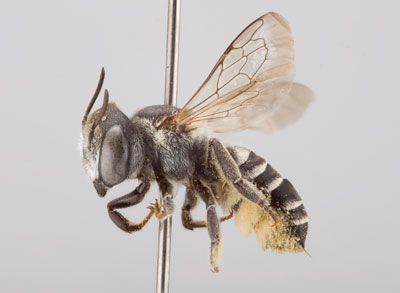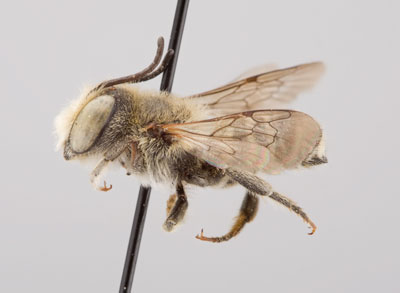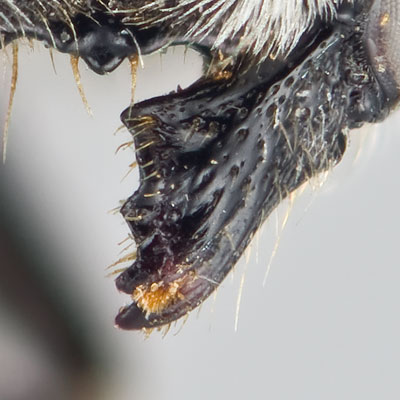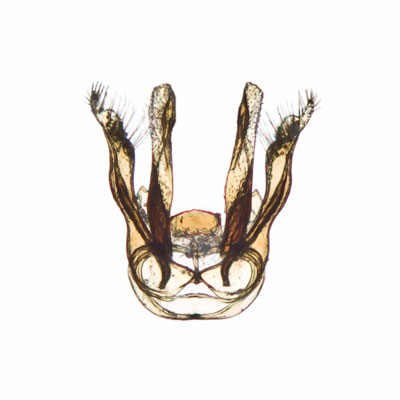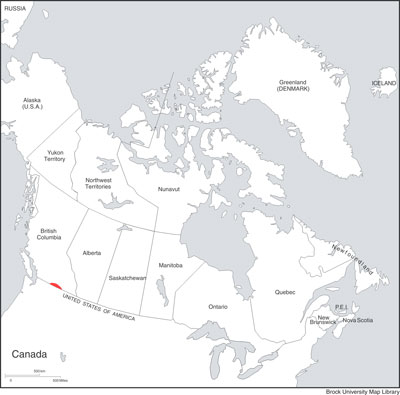
5. Megachile (Eutricharaea) apicalis Spinola, 1808
Megachile apicalis Female |
Megachile apicalis Male |
Megachile apicalis Spinola, 1808. Insect. Ligur. 2: 259 (♀).
Megachile mixta Costa, 1863. Atti accad. Sci. fis. Napoli. 1(2): 44 (♀).
Megachile dimidiativentris Dours, 1873. Rev. Mag. Zool. (3) 1: 300 (♀).
Megachile massiliensis Pérez, 1902. Proc.-verb. Soc. linn. Bordeaux 57: 121 (♂).
Megachile virginiana Mitchell, 1926. Trans. Amer. Entomol. Soc. 52: 113 (♀).
Diagnosis.The female of M. apicalis can be recognized by the combination of dense, white apical fasciae on the metosomal sterna (i.e., beneath the scopa), the dull, impunctate fovea-like patches found laterally on T2, the apical edge of clypeus being angulate medially, and the scopa being black apically and laterally on S4, entirely so on S5 and S6. It is most similar to M. rotundata. Females of M. rotundata have a nearly straight clypeal margin, and the scopa entirely pale on S4 with some pale hairs basally on S5. The male of M. apicalis is recognized by the dull, lateral, impunctate areas of both T2 and T3, and the mostly dark tarsomeres (which may be yellowish basally). It is most similar to M. rotundata. Males of M. rotundata have the dull, lateral, impunctate areas only on T2, and tarsomeres 4 and 5 largely yellow.
FEMALE: Length 8-9 mm.
Head:
Figure M5: Megachile apicalis female mandible |
1) compound eyes slightly convergent below; lateral ocelli subequally distant from eyes and margin of vertex, 2) clypeus with apical margin angulate medially, surface of apical angulation shiny and impunctate, 3) mandibles 4-dentate, but margin of 4th tooth very slightly angulate, thus approaching a 5-dentate condition, with a cutting edge between 3rd and 4th teeth (Figure M5), 4) gena narrower than compound eye (5:7), 5) punctures of vertex fine and close but quite deep and distinct, becoming somewhat more shallow and obscure on gena, irregularly so below; frons densely rugose, supraclypeal area largely impunctate medially, closely and rather coarsely punctate on each side, clypeus with a wide and distinct, shining and impunctate median line, punctures on lateral edges rather coarse and densely crowded, 6) pubescence white, rather short on face, rather dense around antennae and on face laterally, sparse, erect and rather elongate on vertex, hairs yellowish with dark hairs intermixed; pubescence of gena short above, somewhat more elongate below, 7) F1 and F2 quadrate and subequal in length, slightly shorter than pedicel, which is longer than broad (2:1.5), remaining flagellomeres slightly longer, but almost quadrate, apical flagellomere longer than broad (5:3).
Mesosoma:
1) pubescence short, white laterally and posteriorly, quite dense around pronotal lobes and behind wing bases, very short and and almost entirely lacking on mesoscutum, scutellum with more elongate, erect hairs along posterior edge, 2) dorsal surface densely punctate throughout, punctures rather coarse in centre, lateral faces of pleura somewhat shining, with punctures somewhat shallower but contiguous, becoming somewhat finer and crowded above, larger and sparser below, propodeum somewhat more shining, punctures irregular, minute and vague, triangle somewhat shiny and impunctate, becoming somewhat rugose basally, 3) all basitarsi shorter and somewhat narrower than their tibiae, spurs yellow, 4) tegula brownish-black, with only a few, scattered, minute and obscure punctures, 5) wings subhyaline, veins black.
Metasoma:
1) disc of T2 with a dull, sublateral, impunctate area, fovea-like, distinct from remaining surface of disc; apical margins of T2-T5 rather abruptly depressed laterally but not medially, with entire, whitish, apical fasciae that are quite dense laterally, narrow medially; T1 with sparse, elongate, whitish pubescence that is denser laterally, T2-T4 with very short, black discal pubescence, T2-T6 with conspicuous, black hairs evident on each side in dorsal view, T6 nearly straight in profile, with numerous, suberect, black hairs evident on disc, without pale tomentum; punctures fine and close on the more basal terga, T3-T5 with punctures quite deep, distinct, and well separated, fine and close to rugose on apical edge; T6 surface very finely and quite densely punctate, 2) scopa entirely pale on S2 and S3, pale basally but more or less black apically and laterally on S4, entirely black on S5 and S6; the more basal sterna very closely and rather finely punctate, punctures becoming somewhat more coarse and sparse on the apical sterna; apical margins narrowly depressed, distinctly white fasciate beneath scopa.
MALE: Length 6-8 mm.
Head:
1) compound eyes convergent below; lateral ocelli subequally distant from eyes and margin of vertex, 2) median third of clypeal margin slightly incurved, 3) mandibles 3-dentate, lower process slender and acute, subbasal in position, 4) gena considerably narrower than compound eye (3:4), 5) punctures of vertex very close, rather fine but deep and distinct, becoming somewhat finer and more shallow on gena; face below ocelli rather finely rugosopunctate, clypeus very finely and densely rugose, 6) pubescence of face and vertex pale yellow to white, dense around antennae and over lower portion of face, supraclypeal area with very dense, subappressed, upwardly directed hairs that completely hide surface, clypeal pubescence more erect, slightly down curved at tips, but largely obscuring surface, that on vertex sparse and erect, yellowish-white on gena above, becoming white, very long and dense below, 7) F1 broader than long (1.5:1), slightly shorter than pedicel which is quadrate, remaining flagellomeres longer than broad (5:4), apical flagellomere slender and elongate (7:3).
Mesosoma:
1) pubescence yellowish-white, quite dense laterally and posteriorly, slightly sparser on mesoscutum, not obscuring surface beneath, pubescence more elongate and erect on scutellum, 2) dorsal surface dull, surface densely and finely rugosopunctate, punctures of pleura somewhat coarser but densely crowded; propodeum rather smooth, with only exceedingly minute, sparse punctures, triangle dull and impunctate, 3) front coxal spine spatulate, rather broad and quite short, densely white pubescent posteriorly, coxa rather densely white pubescent laterally but largely bare toward inner side, no red bristles evident; front tarsus slender and simple, with a very short but rather dense, posterior fringe, tarsomeres largely dark, yellowish at base; front tibia largely black, and front femur largely black on posterior face, apical half of anterior face quite conspicuously yellowish-brown, lower margin only obscurely carinate and yellow not invading margin of posterior face; mid tibial spur well developed, mid and hind tarsi slender and simple, spurs yellow, 4) tegula brownish-black, minutely and closely punctate, 5) wings subhyaline, somewhat clouded apically, veins black.
Metasoma:
1) disc of T2 and T3 with dull sublateral, impunctate areas; T3 and T5 with basal grooves very shallow, subcarinate with basal fasciae arising from under the edge of the carina; apical margins of T2-T5 rather deeply depressed laterally but not medially, with dense, complete, whitish or yellowish fasciae; T1 with copious, erect, entirely pale pubescence, becoming very dense laterally, disc of T2 rather densely covered with suberect, pale hairs that do not hide surface, T3 and T4 with shorter, more obscure, suberect pale pubescence; punctures of terga close medially, fine on T2 and somewhat coarser on T3 and T4; T5 densely pale tomentose across base, with suberect, somewhat darker hairs apically, apical margin deeply depressed laterally but not in centre, punctures rather irregular but quite coarse and close, apical margin without fascia; T6 very densely pale tomentose, largely hiding surface, carina very low and irregularly crenulate, median emargination small and obscure, apical margin without distinct median teeth, and lateral angles very obscure; T7 transverse, flattened, not at all produced medially, 2) S1-S4 exposed, finely and rather closely punctate, punctures becoming very fine apically on S4, S2 and S3 quite deeply depressed apically, yellowish hyaline, with quite dense fringes of rather elongate, white hairs.
Genitalia: Figure G5.
|
Figure G5: Megachile apicalis genitalia |
Discussion:
At least three species of the subgenus Eutricharaea Thompson have been introduced into the western Hemisphere (Michener 2007); both of our species are of Eurasian origin. First reported as established in North America by Cooper (1984), here we report this species for Canada for the first time; a series of specimens were collected in BC: Mt. Kruger (49.0296N; 119.4926W; 415 m), Osoyoos, Okanagan-Similkameen Reg. Dist., 29.vii.2008; L.R. Best. Megachile apicalis nests in pre-existing cavities, and can be trap-nested (Barthell et al. 1998) (Table 1). Trostle and Torchio (1994) detailed the nesting and development.
Distribution:
This species occurs in southern BC (see Map 5).
|
Map 5: Canadian distribution of Megachile apicalis |
